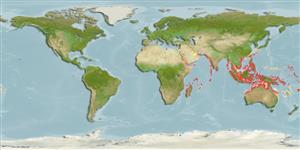Teleostei (teleosts) >
Acanthuriformes (Surgeonfishes) >
Leiognathidae (Slimys, slipmouths, or ponyfishes) > Gazzinae
Etymology: Karalla: Karalla is the local name for ponyfishes in Sri Lanka and the surrounding region where members of this genus commonly occur.
Eponymy: Jean-Jacques Dussumier (1792–1883) was a French merchant, collector, traveller and ship owner. [...] (Ref. 128868), visit book page.
More on author: Valenciennes.
Environment: milieu / climate zone / depth range / distribution range
Ecology
Marine; brackish; demersal; depth range 10 - 40 m (Ref. 47581). Tropical
Indo-West Pacific: Madagascar, Reunion, India, Sri Lanka, through Indonesia and the Philippines.
Size / Weight / Age
Maturity: Lm ? range ? - ? cm
Max length : 14.0 cm TL male/unsexed; (Ref. 47581); common length : 11.0 cm TL male/unsexed; (Ref. 47581)
Found in coral sand bottoms of coastal waters, but also enters estuaries (Ref. 47581). Feeds on small crustaceans, polychaetes, bivalves, foraminiferans, gastropods and nematodes (Ref. 47581). Forms schools (Ref. 47581). Sold dried salted in markets, and also used for fishmeal (Ref. 3424).
Life cycle and mating behavior
Maturity | Reproduction | Spawning | Eggs | Fecundity | Larvae
Woodland, D.J., S. Premcharoen and A.S. Cabanban, 2001. Leiognathidae. Slipmouths (ponyfishes). p. 2792-2823. In K.E. Carpenter and V.H. Niem (eds.) FAO species identification guide for fishery purposes. The living marine resources of the Western Central Pacific. Volume 5. Bony fishes part 3 (Menidae to Pomacentridae). Rome, FAO. pp. 2791-3380. (Ref. 47581)
IUCN Red List Status (Ref. 130435: Version 2024-1)
Threat to humans
Harmless
Human uses
Fisheries: commercial
Tools
Special reports
Download XML
Internet sources
Estimates based on models
Preferred temperature (Ref.
123201): 25.3 - 29.1, mean 28.3 °C (based on 836 cells).
Phylogenetic diversity index (Ref.
82804): PD
50 = 0.7500 [Uniqueness, from 0.5 = low to 2.0 = high].
Bayesian length-weight: a=0.01445 (0.00755 - 0.02768), b=2.95 (2.78 - 3.12), in cm total length, based on LWR estimates for this species & (Sub)family-body (Ref.
93245).
Trophic level (Ref.
69278): 3.2 ±0.38 se; based on food items.
Resilience (Ref.
120179): High, minimum population doubling time less than 15 months (Preliminary K or Fecundity.).
Fishing Vulnerability (Ref.
59153): Low vulnerability (10 of 100).
Nutrients (Ref.
124155): Calcium = 568 [75, 1,776] mg/100g; Iron = 3.66 [0.98, 10.46] mg/100g; Protein = 18.8 [16.7, 20.8] %; Omega3 = 0.228 [0.106, 0.498] g/100g; Selenium = 60.1 [19.0, 186.9] μg/100g; VitaminA = 15.1 [4.6, 47.1] μg/100g; Zinc = 2.22 [0.97, 4.10] mg/100g (wet weight); based on
nutrient studies.
